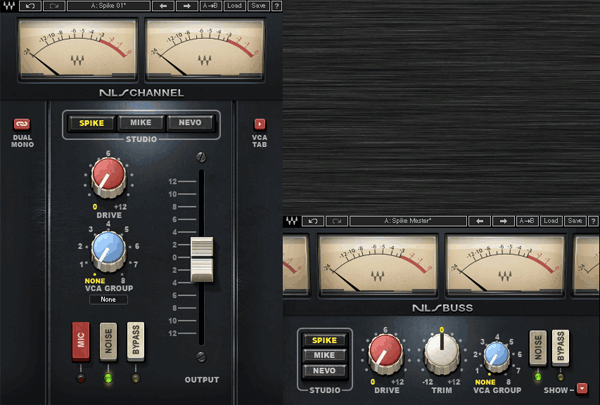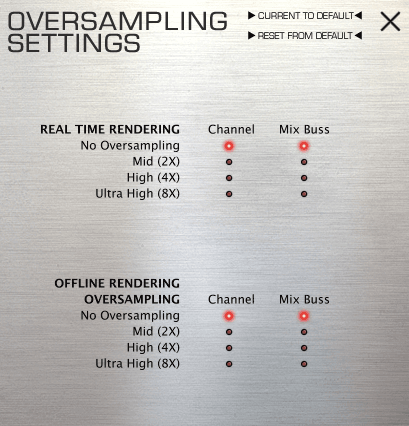The vogue these days in computer audio
(and one I am not immune to) is to distance one’s sound from the
digital domain as much as possible. Countless virtual emulations of
vintage gear are released seemingly every week and marketed as the
perfect marriage of analogue authenticity and digital cost
effectiveness.
One unique sub-genre of these vintage plugins are the
analogue summing mixer emulations; designed to recreate the enhanced
sense of depth, width and punch a mix would have if it were run
through and summed on an analogue desk. Although there are several
virtual consoles out there, this article (at least for demonstration
purposes) will largely revolve around the Steven Slate Digital
Virtual Console Collection and the Waves NLS.
What Are They?
Almost every version of console emulation comes as a bundle of two plugins, one for the channel
strips and one for the mix bus. The set up is to simply place a
channel plugin on each of the channels and the bus plugin on the
output.
The channel plugins can be placed as either the first or
last insert (to emulate mixing or tracking respectively), while the
bus plugin should always be placed first in order to replicate an
unaltered sum. These plugins will not do any summing of their own
(some confusion has been created by the Nonlinear Summing title of
the Waves version) but will alter harmonics, EQ curve, saturation,
crosstalk and noise level in a nonlinear way dependent on source
material frequency and level.

Basic Use
The most important control in any of
the emulations is the console type. In the Slate version there are
five different types of consoles to choose from with unique
characteristics (for some legal reason I presume, each is codenamed).
The Brit 4k is an SSL clone, the US A is an API, the Brit N is a
Neve, the trident symbol is, not surprisingly, a Trident desk and the
RC-Tube is a 1950’s all tube broadcast console. The NLS also covers
Neve and SSL as well as an EMI emulation.
In the VCC the Input control will
increase or decrease incoming gain which in turn changes the effect
the channel and bus plugins have on the audio. The Drive control
will increase or decrease the intensity of the effect without
altering gain. It is also possible to denote channel groups and
slave them to a single control which will uniformly change group
parameters across the board. Assigning the mix bus to a group is
also possible.
The NLS is somewhat different in that
it contains only the Drive knob which acts as the input knob in the
VCC. It also contains an output slider to adjust the signal sent to
the summing bus post channel strip.

Slate’s Advanced Options
The Calibration panel in the Steven
Slate version allows for configuration of how the console will react
to input level either globally or by group. Here, you can adjust the
console to react to lower level signal as if it were being driven
hard or vice versa. The Rel LED sets the calibration to react
relative to the global calibration level, the Abs LED sets
calibration to an absolute value, irrespective of the global setting.
The On LED activates the particular group calibration and the slider
determines the intensity.

The Output panel provides control for
desk noise (turning hiss on or off when there is no signal), desk level according to type, control over the level and sensitivity
of the level Clip LED as well as a control for the responsiveness of
the VU meter needles.

The Oversampling panel provides a
variety of oversampling options for rather dramatic effect. As is,
the plugin will not oversample and sounds pretty good. However, by
oversampling one can achieve a more realistic emulation of the
analogue desk (or so claims Steven Slate). There are options to
oversample by 2, 4 and 8 times in both offline and realtime
rendering.

Taste Test
Here is a quick blind taste test
between the Waves Non-Linear Summer and the Slate VCC. Both emulate
a Neve and SSL desk so I’ve chosen those for an apples to apples
comparison below.
T
The dry loop
Neve Desk 1
Neve Desk 2
SSL 1
SSL 2
In both tests, the VCC is second. I actually prefer the Waves Neve in this instance, but after demoing it for
sometime, I did feel the NLS tended to generally over color the sound, which brought me to my purchase of the VCC.
One cool thing about the NLS that is
not present in the VCC or other emulators that I am aware of is that
around 30 different channel strips from each desk were modeled. If
set up properly, Waves will randomly select from this pool to give up
to 30+ unique channel emulations per project. Waves also offers a
duel mono mode in the NLS which creates a slight variation between
the left and right channels, further widening the stereo field.
The Sounds
Below are samples of the same kick and
snare loop run through both the NLS and VCC. I changed no parameters
other than the desk type.
NLS
Neve again
SSL again
EMI
VCC
SSL again
API
Neve again
Trident
Tube
A hybrid I made of the VCC with the
kick running through the tube, snare running through the Trident, the
Neve handling the hi hat, and the mix bus set to API.
The hybrid oversampled by a factor of
8. The snare and hi hat sound
quite a bit more clear and distinct.
Should You Buy One?
In all honesty, the only people who
really know how closely any of these emulations come to recreating
the sound of a vintage piece of gear are those who actually have
access to the gear being modeled. For my money though, it stands to
reason by virtue of the laws of competition that they are not too far
off, or at least close enough to make dropping $150 or so a worth
while investment.
Two other contenders I have not yet mentioned are
the Sknote Stripbus and the Acustica Nebula (not quite the same
thing, but can be used as such) which I have not tried but have
heard good things about. So by all means demo them out and decide
for yourself if it is money well spent and a sound worth pursuing.
{excerpt}
Read More